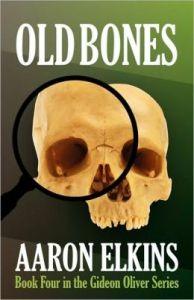 An ingenious murder kicks off this award-winning Gideon Oliver mystery.
An ingenious murder kicks off this award-winning Gideon Oliver mystery.
The story opens with a man exploring the tidal pools of Mont St. Michel Bay, but who appears lost in thought. “For many minutes he remained so, unmoving, lost in reflection, and then he tensed suddenly.” He hears the tide rushing in.
“The tide! How could he have lost track of time so completely? It hardly seemed possible, but there was no mistaking the sound of it, nor the rush of cool, salt-laden air that streamed before it.”
He tries to escape the incoming tide, but is caught by it and drowned. It would seem he had tarried too long, losing track of the time, but later it is discovered that someone had tampered with the man’s Annuaire des Marées, the timetable booklet of tides.
The drowned man, Guillaume du Rocher, had recently convened a family council. “The patriarchal Guillaume du Rocher convened these ‘family councils’—formal meetings of the dwindling and far flung du Rocher clan—whenever it pleased him, and he ran them however he wished.” The family complied (“What choice was there?”) for they anticipated their inheritance.
The family included the du Rochers: domineering Mathilda, her absent-minded husband René, and their gluttonous son Jules; and the Fougerays: choleric Claude, his fiery wife Leona, and their meek daughter Claire; René and Guillaume’s sister Sophie and her Texas husband, Ben Butts, and their affable nephew, Raymond Schaefer.
Buried tensions between the family members have been exacerbated by Guillaume’s “lordly summons. They’d been brought together at Manoir de Rochebonne, the familial estate in need of repairs, because Guilluame had “reached a decision on a matter of singular family importance.”
Uncharacteristically, Sophie loses her temper and blames Claude for the death of Alain du Rocher. Later, she fills in her nephew Raymond on the backstory.
“Early in the war, our parents were killed and our home was destroyed. All of us—Alain, René, and I—came here, to the domaine, to live with Guillaume.”
Alain, Sophie’s older half-brother, was killed during World War II. When the Germans came to Ploujean to stamp out the local Resistance efforts, Alain was betrayed, arrested, and executed in the basement of the town hall along with five other Resistance fighters. A plaque in town square commemorates the fallen. Guillaume assassinated the SS officer responsible and fled, joining up with the Resistance elsewhere until the war’s end.
Sophie blames Claude for Alain’s death, suspecting him of having been a collaborator with the Germans and the one responsible for betraying Alain.
When Guillaume’s will is read, the estate is primarily left to René and Mathilda. All would seem settled until Claude insists, “There was going to be a new will.”
The next day, workmen arrive to begin work on the drains. “The ancient household drains had been showing their age in unpleasant ways for some time, but Guillaume, for reasons of his own, had chosen to ignore the problem…” Soon after, the workmen discover a body, or rather, the remains of one.
Meanwhile, as the du Rocher familial drama is unfolding, Forensic Anthropologist Gideon Oliver, the “skeleton detective,” is giving a presentation at the Eighth Annual Conference on Science and Detection in St. Malo, France. In attendance is Inspector Lucien Anatole Joly.
As a result of the workmen’s discovery at Manoir de Rochebonne, Inspector Jory is recalled from the conference to investigate, and he, in turn, invites Gideon Oliver to come with him and view the skeletal remains.
Turns out, Gideon is quite familiar with the du Rocher residence. On a previous trip to France, while working on an Upper Paleolithic dig in the Dordogne, Gideon was invited to Rochebonne by an acquaintance of his, Raymond Schaefer. Ray had invited Gideon to spend a weekend at the family domaine, and during that time Gideon met and befriended Guillaume.
Initially, Gideon is able to confirm the remains date some forty years ago (to the time of the Second World War), and that it is the body of a man “under forty and over thirty.”
Joly theorizes: “there’s always the Occupation to consider. You know, there was a lot of Resistance activity in Brittany. And the village of Ploujean was the scene of a mass execution in 1942.” … “There were a lot of unsolved deaths; a lot of mysterious disappearances at that time.
On the surface it would seem that any crime was buried in the past along with the skeleton, but then another member of the du Rocher family is poisoned. Very much in the present. And after using a doctored Annuaire des Marées, Gideon begins to suspect that Guillaume, too, was murdered.
The pieces begin to come together when he notices a peculiarity of the skeletal remains that lead to a shocking revelation.

An aerial view of Mont St. Michel at low tide and a scene of the crime in Old Bones.
Published in 1987, Old Bones is the fourth book in Aaron Elkins’ Gideon Oliver mystery series. It won the Edgar Award for Best Mystery. And rightfully so. It’s very much like reading a classic Golden Age mystery (but set in more contemporary times) with a carefully constructed puzzle plot and well-drawn characterizations that garner more interest than the genre’s typical stock characters. As an added bonus, readers get to be armchair travelers as the novel evokes the sights (and rich history) of the Normandy coast in and around Mont St. Michel.
It’s a pleasant, satisfying read for a cozy afternoon.

